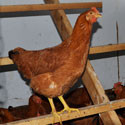
At dusk, chickens instinctively seek a high place to spend the night where they feel safe from predators. Lacking a comfortable place to roost inside their coop, they may seek an outdoor roost. It might be the top of a fence or gate, in a tree, or even on the coop roof. Chickens that roost outdoors are vulnerable to predators. Providing comfortable perches inside the coop gives them a safer place to spend the night.
You can start training chickens to use roosts while they are young. By the time light breeds reach four weeks of age and heavy breeds about six weeks, they’re ready to roost on low perches. When chicks in a brooder start perching on top of feeders and waterers, you know they are looking for a practice roost.
Not only is nighttime roosting a natural and healthy habit, but hopping on and off perches during the day is good entertainment (for both you and your birds), as well as being good exercise for growing chicks. Further, providing practice perches while the birds are still young helps ensure you won’t have the job of convincing chickens to roost indoors when they are moved to their adult quarters.
Practice perches may be made of ¾-inch diameter wooden dowels or 1-by-2 lumber with the narrow side turned upward and the edges rounded off. Allow 4 inches of roosting space per bird, but make the total length of each perch no more than about 3 feet so it won’t sag under the weight of multiple birds. If brooder space allows, provide a variety of perch heights, such as 3 inches, 6 inches, and 12 inches. Periodically increase perch height as the chicks grow.
When they reach maturity, lighter breeds and game breeds seem to be more comfortable roosting higher than heavier breeds. Cackle Hatchery takes the guesswork out of comfortable roost heights by including this information in the “Breed Facts” description for each breed.
A good way to make sure all your birds are comfortable is to continue providing a variety of perch heights, arranged like the steps of a ladder. Offsetting the roosts has two advantages: birds that roost lower won’t get pooped on during the night by those on higher perches, and birds that don’t fly well can start at the lower level and hop to the next higher level until they reach their comfort zone.
The circumference of the roosting bar should be no less than the length of a mature chicken’s foot, as measured from the end of the middle toe to the end of the hind toe when the foot is flat on the ground. If you use dimensional lumber with rounded-off edges, a reasonable size for most mature chickens is 2-by-2. If you prefer, you could use tree limbs or thick wooden dowels of comparable size.
Provide enough roosting space so all your chickens have no trouble finding a place to perch. Allow a minimum of 8 inches for each chicken, or 10 inches for the larger breeds. Place roosts at least 18 inches from the nearest parallel wall, and space them 12 inches apart both vertically and horizontally. You will find that your more dominant birds will roost on the higher levels. If you keep chickens and guinea fowl together, the guineas will invariably muscle their way up to the highest roosts.
And that’s today’s news from the Cackle Coop.
Gail Damerow, author, Storey’s Guide to Raising Chickens

